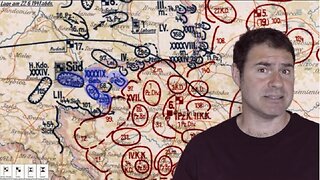Premium Only Content

German Armor in OPERATION DOOMSDAY 1945 in Norway - RAW footage episode № 1
🔥PREVIEW ALL YOUTUBE VIDEOS
www.Patreon.com/Military1945
GERMAN SURRENDER
Episode № 1
Military1945
Episode № 277
Be sure to give this video a THUMBS UP! Best way to support the channel!
SUBSCRIBE to M1945
In Operation Doomsday, the British 1st Airborne Division acted as a police and military force during the Allied occupation of Norway in May 1945, immediately after the victory in Europe during the Second World War. The division maintained law and order until the arrival of the remainder of Force 134, the occupation force. During its time in Norway, the division was tasked with supervising the surrender of the German forces in Norway, as well as preventing the sabotage of vital military and civilian facilities.
The German Instrument of Surrender was delivered on 8 May to General Franz Böhme, the commander of all German forces stationed in Norway, and the 1st Airborne Division landed near Oslo and Stavanger between 9 and 11 May. The majority of the transport aircraft carrying the division landed safely, but three planes crashed with a number of fatalities. The division encountered little of the expected German resistance. Operational duties included welcoming back King Haakon VII of Norway, looking after Allied ex-prisoners of war, arresting war criminals and supervising the clearing of minefields. The division was also able to confirm the deaths of the British airborne troops that had taken part in Operation Freshman, an unsuccessful attempt to disrupt the German atomic weapons program in November 1942. The division returned to Britain at the end of August and disbanded two months later.
Since 1943 the Western Allies had been developing plans for the occupation of Norway, code-named Operation Apostle, after Germany's surrender.[2] Force 134, the occupation force, was composed of Norwegian troops who were stationed in Scotland, as well as a British contingent , a few American troops,[3] and some 12,000 Norwegian police troops stationed in neutral Sweden. In the event of an emergency, the Supreme Headquarters Allied Expeditionary Force would deploy troops into Norway from Germany.
Two separate scenarios were considered in planning for Operation Apostle. The first, known as 'Rankin C (Norway)' was based on the assumption that all German forces occupying Norway would surrender as part of a more general unconditional surrender by Germany. The second was known as 'Rankin B' and assumed that there was no surrender and that only parts of Norway would be abandoned by the Germans in order to reinforce their troops stationed in north-western Europe against Allied advances there; in this scenario, Force 134 would encounter heavy German resistance.[2] The development of plans for the liberation and administration of Norway were complicated by it being difficult to predict whether the landings would be opposed by German forces and the extent of damage resulting from Allied bombardments and any German "scorched earth" demolitions. As a result, planning for the administration of Norway was detailed and flexible.
Either of the two 'Rankin' scenarios would be difficult for Thorne to accomplish however, as the troops allocated to Force 134 were meagre; from late 1943 onwards the majority of military resources were dedicated to the campaign in north-west Europe. In September 1944 Thorne was even deprived of 52nd Lowland Division, which was attached to the 1st Allied Airborne Army by the War Office and earmarked for Operation Market Garden. Instead Thorne was later given the 1st Airborne Division, under the command of Major General Roy Urquhart. However, owing to the heavy casualties the division had suffered during Market Garden it would not be combat ready until 1 May 1945 after being heavily reinforced. In order to bolster his forces, Thorne would therefore have to rely on Milorg, the Norwegian Resistance.[2] The Allied civil affairs planners maintained very close contact with the Norwegian Government in exile which was based in London as well as Milorg.[7] As a result, by the end of the war Milorg had been preparing for the arrival of an Allied force for some time; its 40,000 members were well-armed and trained, and led by more than 100 Special Operations Executive agents parachuted into Norway, and it was prepared to prevent any sabotage of key communication centres and other important facilities by German troops if they resisted the Allied forces.
-
 12:10
12:10
Military1945
3 months ago1st Mountain Division - Edelweiss - 1. Geb. - Brandenburger - Nachtigall - Lviv - Lemberg - OUN-R
186 -
 LIVE
LIVE
Matt Kohrs
10 hours agoMARKET OPEN: Bounce or Bust?! || Live Trading
721 watching -
 LIVE
LIVE
The Mike Schwartz Show
2 hours agoTHE MIKE SCHWARTZ SHOW with DR. MICHAEL J SCHWARTZ 07-17-2025
4,231 watching -
 4:03
4:03
Blackstone Griddles
15 hours agoBlackstone Smokeless Fire Pit Overview | Blackstone Griddles
6.17K1 -
 15:48
15:48
Professor Gerdes Explains 🇺🇦
22 hours agoDecoding the Battlefield: What Actual Combat Says About Russia and Ukraine
3.68K1 -
 1:30:59
1:30:59
Chicks On The Right
5 hours agoTrump's latest wins, Trump triples down on insulting his base, and Obamas talk divorce
14.6K13 -
 25:44
25:44
Producer Michael
21 hours agoTHE TOP-SECRET DIAMOND TRADE WORTH $38 BILLION YOU'VE NEVER HEARD OF!
21.1K2 -
 24:55
24:55
World2Briggs
19 hours ago $5.27 earnedDenver's 25-Year Collapse: The Timeline Nobody Wanted to Believe
34.5K43 -
 10:39
10:39
ARFCOM News
19 hours ago $2.99 earnedFeds Cave on 18yr Olds | Gun-Free Zones = Loot Drops | Cops Drop Sig 320
22.6K6 -
 8:08
8:08
The Car Guy Online
18 hours ago $3.05 earnedFord’s SHOCKING 'Solution' for 694,000+ Fire-Prone SUVs! Bronco Sport and Escapes.
34K13